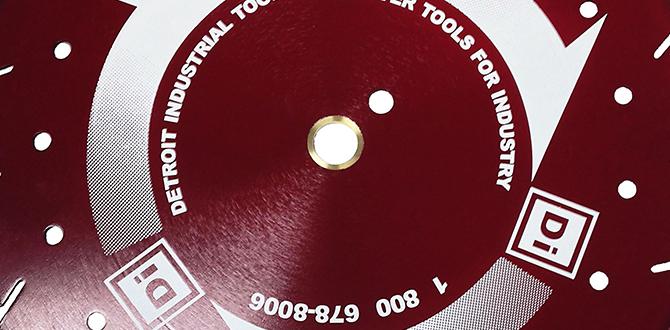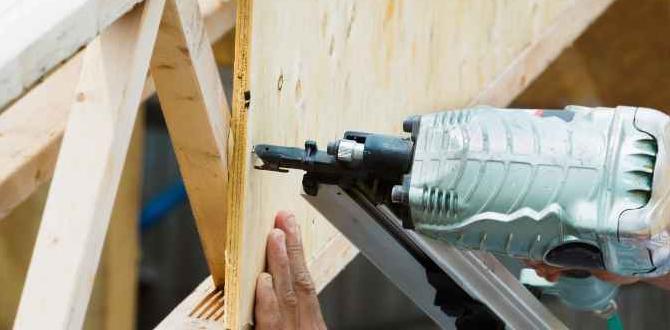Quick Summary: Choosing a battery-powered nailer is easier than you think! This guide compares top models, explains their uses, and helps you pick the best cordless nailer for your DIY projects based on power, features, and budget. Get ready to build with confidence!
Hey there, fellow makers and DIY enthusiasts! Jack Shaffer here, your go-to guy for all things nailers. Are you tired of wrestling with air hoses or dealing with the hassle of gas cartridges for your nailing jobs? If you’re looking to bring more freedom and convenience to your projects, battery-powered nailers are a game-changer. But with so many options out there, how do you know which one is right for you? It can feel a bit overwhelming, right? Don’t worry! I’m here to break down the world of cordless nailers. We’ll explore what makes them tick, compare some of the best on the market, and figure out which one will be your new favorite workshop buddy.
Table of Contents
Why Choose a Battery Powered Nailer? The Cordless Revolution
Battery-powered nailers, often called cordless nailers, are taking the DIY world by storm, and for good reason! They offer incredible freedom. No more tripping over air hoses or dealing with the fumes and mess of gas-powered nailers. Just grab your tool, a charged battery, and you’re ready to go. This makes them perfect for quick repairs around the house, completing trim work, or even tackling larger projects without being tethered to a compressor.
Think about it: installing baseboards, building a birdhouse, or even framing a small shed. With a cordless nailer, you can move around your worksite effortlessly, getting into tight spots and working at any angle. Plus, they’re getting more powerful and efficient with every new model that comes out. They represent a significant leap in convenience and performance for both seasoned woodworkers and eager beginners.
Understanding the Technology: How Do They Work?
Before we dive into comparisons, it’s helpful to understand the magic behind battery-powered nailers. Unlike pneumatic nailers that use compressed air, or gas-powered ones that use combustion, cordless nailers rely on a battery and a motor to drive the nail. There are a couple of main technologies at play:
- Motor-Driven (or Flywheel) Technology: This is like a small, internal slingshot. The motor spins a flywheel at high speed, and when you pull the trigger, a clutch engages, releasing the stored kinetic energy to drive the nail. These are generally good for smaller nails like brad nails and finish nails.
- Pneumatic Power (Air). Battery Powered Pneumatic (BPP) Nailers: These ingenious tools still use compressed air, but the air is stored in a small onboard chamber. The battery-powered motor compresses air into this chamber between drives. When you pull the trigger, the compressed air is released instantly to drive the nail, mimicking the feel and power of a traditional pneumatic nailer but without the external compressor. These are excellent for framing and heavier-duty tasks.
The battery is the heart of these tools. Modern lithium-ion batteries are lightweight, hold a charge for a long time, and recharge relatively quickly. The voltage of the battery (e.g., 18V, 20V) often indicates the power capability of the tool.
Types of Battery-Powered Nailers: Finding Your Fit
Just like their air-powered cousins, battery-powered nailers come in different flavors, each designed for specific jobs. Knowing the difference will save you time and frustration later.
1. Brad Nailers
Ideal for smaller, intricate work and where minimal hole size is preferred. They drive thin, small-headed nails (hence “brad”) around 18-gauge. Perfect for attaching delicate trim, quarter round, crown molding, or any project where you want nails to be almost invisible.
- Pros: Very lightweight, minimal nail holes, excellent control, great for delicate materials.
- Cons: Not powerful enough for heavy-duty tasks or structural work.
- Typical Projects: Installing trim, furniture assembly, craft projects, attaching decorative molding.
2. Finish Nailers
These are a step up from brad nailers, using 15 or 16-gauge nails with slightly larger heads. They offer a good balance of holding power and aesthetics. Finish nailers are fantastic for installing baseboards, window and door casings, and cabinet trim without pulling materials apart.
- Pros: Good holding power, relatively small nail holes, versatile for many trim jobs.
- Cons: Still not suitable for framing or structural applications.
- Typical Projects: Baseboards, door/window trim, chair rails, cabinetry installation.
3. Framing Nailers
This is where you get serious power. Framing nailers use larger gauge nails (typically 2-inch to 3.5-inch) to assemble the structural framework of a building—walls, floors, and roofs. Battery-powered framing nailers bring the power and convenience of cordless technology to the most demanding construction tasks.
- Pros: Drives large nails for strong connections, powerful enough for dimensional lumber, no compressor needed for framing.
- Cons: Heavier than brad or finish nailers, larger nail holes, can be overkill for trim work.
- Typical Projects: Building walls, decks, fences, sheds, framing houses.
4. Roofing Nailers
Designed specifically to attach shingles to roofs. They have a distinctive magazine that allows for quick, repetitive nailing. While pneumatic roofing nailers are still very common on professional job sites, battery-powered versions are becoming more accessible for homeowners tackling roof repairs or smaller roofing projects.
- Pros: Optimized for shingle installation, fast nailing, built for weather.
- Cons: Highly specialized, not useful for general carpentry.
- Typical Projects: Re-shingling a roof, minor roof repairs.
5. Pin Nailers
The smallest of the bunch, pin nailers use virtually headless nails (they have a tiny pin sticking out that you can break off or ignore). They are excellent for holding pieces in place temporarily while glue dries, or for very delicate decorative applications where no nail head can be visible.
- Pros: Completely invisible fastener, precise placement, lightweight.
- Cons: No holding power on their own, only for very light tasks or temporary fastening.
- Typical Projects: Holding delicate trim in place while gluing, small craft projects, where absolute invisibility is key.
Key Features to Consider in Your Battery Nailer Comparison
When you’re comparing different battery-powered nailer models, a few features will make a big difference in your experience. Let’s break down what to look for:
- Power Source: As we discussed, some are motor-driven for lighter tasks, while others use stored compressed air, which offers more “oomph” for heavier nails. For framing, you’ll definitely want a BPP system with a robust battery.
- Battery Platform: Many manufacturers have a broad line of tools that use the same battery system. If you already own tools from a brand like DeWalt (20V MAX), Makita (18V LXT), Milwaukee (M18), or Ryobi (ONE+), sticking with that brand can save you money as you won’t need to buy extra batteries or chargers.
- Battery Capacity (Ah – Amp Hours): This tells you how long a battery will last on a single charge. Higher Ah batteries (e.g., 4.0Ah, 5.0Ah) will run longer but are also heavier and more expensive. For most DIYers, a 2.0Ah to 3.0Ah battery is a good starting point.
- Depth Adjustment: This is crucial for setting nails flush with the surface or countersinking them slightly. Look for an easy-to-use, tool-free depth adjustment mechanism.
- Tool-Free Jam Release: Jams happen, especially with new tools. A quick, tool-free jam release means you can clear a nail without hunting for an Allen wrench, getting you back to work faster.
- Sequential vs. Contact Actuation (Firing Modes):
- Sequential Firing: You must depress the safety contact tip against the workpiece before pulling the trigger. This offers precision for controlled nailing.
- Contact Actuation (Bump Firing): You can hold down the trigger and then bump the nose against the surface to drive nails. This is faster but less precise. Many nailers offer a switch to toggle between modes.
- Nail Capacity: How many nails can the magazine hold? A higher capacity means less frequent reloading during longer jobs.
- Weight: Especially important if you’ll be working overhead or for extended periods. Lighter tools reduce fatigue.
- Ergonomics: How does the tool feel in your hand? Does it have a comfortable grip? Good balance can make a big difference.
- LED Light: A small but useful feature, an LED light can illuminate your work area, especially in dimly lit spaces or tight corners.
Battery Powered Nailer Comparison: Top Picks for DIYers
Let’s get down to brass tacks and look at some popular battery-powered nailer lines that many DIYers trust. Remember, availability and specific models can change, but these brands consistently offer solid cordless options.
1. DeWalt 20V MAX XR Line
DeWalt is a powerhouse in the cordless tool world, and their 20V MAX XR nailers are a favorite among pros and DIYers alike. They offer a wide range of nailers, from brad to framing, all powered by their robust 20V MAX battery system, which is shared across hundreds of their tools.
- Pros: Excellent power and performance, broad tool selection, durable construction, readily available.
- Cons: Can be on the pricier side, especially when buying kits with batteries.
- Best for: Homeowners and hobbyists who want reliable, no-nonsense tools and might already be invested in the DeWalt platform.
2. Makita 18V LXT System
Makita is another industry leader known for its high-quality tools and extensive 18V LXT battery platform. Their cordless nailers are praised for their performance, speed, and often, their lighter weight compared to some competitors. They offer nearly every type of nailer you can imagine within this system.
- Pros: Great power-to-weight ratio, long battery life, extensive tool ecosystem.
- Cons: Similar to DeWalt, can be an investment.
- Best for: Users looking for efficient, well-balanced tools and who appreciate the vast Makita 18V LXT selection.
3. Milwaukee M18 FUEL Series
Milwaukee has a reputation for innovation and power, especially with their M18 FUEL line. These tools are often engineered for maximum performance, speed, and efficiency. Their cordless nailers are no exception, offering impressive power, particularly in their framing nailer models.
- Pros: Top-tier power and speed, advanced battery technology, durable and well-built.
- Cons: Typically the most expensive option.
- Best for: Serious DIYers and Pros who demand the highest performance and don’t mind paying a premium for it.
4. Ryobi ONE+ System
Ryobi offers a fantastic value proposition with their ONE+ hệ thống. Their cordless nailers are generally more budget-friendly than the premium brands, making them very attractive for homeowners and DIYers just starting out or on a tighter budget. They often offer good performance for the price.
- Pros: Excellent affordability, wide range of tools on the ONE+ platform, good for intermediate DIY tasks.
- Cons: May not match the raw power or long-term durability of higher-end brands for very heavy use.
- Best for: Budget-conscious DIYers, homeowners tackling occasional projects, and those new to cordless tools.
5. Metabo HPT (Formerly Hitachi) MultiVolt
Metabo HPT’s MultiVolt cordless nailers are impressive because they offer the option to run either on a MultiVolt battery or AC power cord (with an adapter), as well as being compatible with their 18V batteries. This offers incredible versatility.
- Pros: Versatile power options, strong performance, innovative battery technology.
- Cons: Newer to some markets, finding accessories might be slightly less common than major brands.
- Best for: Users who appreciate flexibility and robust power, especially those who might have existing Metabo HPT tools.
Battery Powered Nailer Comparison Chart
To help you visualize the differences, here’s a simplified comparison. Keep in mind that specific model numbers within these lines will have varying features and price points.
| Feature | DeWalt 20V MAX XR | Makita 18V LXT | Milwaukee M18 FUEL | Ryobi ONE+ | Metabo HPT MultiVolt |
|---|---|---|---|---|---|
| Battery Platform Value | Excellent (Broad Tool Range) | Excellent (Vast Tool Range) | Excellent (High Performance) | Good (Very Affordable Entry) | Very Good (Flexible Power) |
| Typical Price Range (Nailer Only) | $$ – $$$ | $$ – $$$ | $$$ | $ – $$ | $$ – $$$ |
| Power/Performance | High | High | Very High | Medium – High | High |
| Durability/Build Quality | Excellent | Excellent | Excellent | Good | Excellent |
| Weight (Varies by model) | Medium | Light – Medium | Medium | Medium | Medium |
| Tool Availability | Very High | Very High | High | Very High | Medium – High |
Note: Price indicators: $ = Budget-friendly, $$ = Mid-range, $$$ = Premium. Actual prices vary by retailer, sales, and kit configurations (tool only vs. battery/charger included).
Getting Started: Your First Battery Powered Nailer Project
Ready to make the leap? Here’s a simple approach to choosing and using your first battery-powered nailer for a common DIY task like installing baseboards.
Step 1: Choose the Right Nailer Type
For baseboards, a 15 or 16-gauge finish nailer is your best bet. It provides enough holding power and leaves a nail hole small enough to be easily filled.
Step 2: Select Your Brand and Model
Consider your budget and any existing tools you have. If you’re new to cordless, Ryobi offers a great entry point. If you plan to do a lot more DIY, investing in DeWalt, Makita, or Milwaukee’s battery platform might be more economical in the long run.
Step 3: Gather Supplies
- Your selected battery-powered finish nailer.
- A charged battery (ensure it’s compatible with your nailer).
- Appropriate nails (e.g., 16-gauge finish nails, 1.5-inch to 2-inch length, depending on baseboard thickness and wall material).
- Safety glasses (always!).
- Work gloves (optional, but recommended).
- Chop saw or miter saw for cutting baseboards.
- Stud finder.
- Measuring tape.
- Pencil for marking.
- Wood filler or putty for filling nail holes.
- Caulk for filling gaps.
Step 4: Prepare Your Workspace
Ensure you have enough light, clear the area of obstructions, and have your materials readily accessible. Make sure your walls are clean and ready for installation.
Step 5: Load the Nailer
Consult your nailer’s manual, but generally, you’ll slide the magazine open, insert a strip of nails (making sure they are oriented correctly for your specific nailer), and close the magazine firmly.
Step 6: Set Depth and Firing Mode
Using a scrap piece of wood first is highly recommended! Adjust the depth setting on your nailer until the nails are driven just below the surface of the baseboard, ready for filling. Ensure the firing mode is set to sequential for precise placement.
Step 7: Find Studs
Use your stud finder to locate the wall studs. Mark their positions lightly with a pencil on the wall where the baseboard



